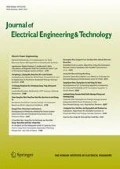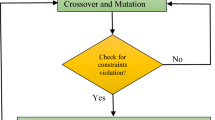Abstract
Optimal placement and sizing of Distributed Generation (DG) are essential for future power planning of distribution networks. The performance of Gravitational Search Algorithm (GSA) and an Improved version of Gravitational Search Algorithm (IGSA) are compared in solving the optimization problem. The multi-objective function optimization includes power loss minimization (Ploss), Minimum bus voltage (Vbusmin), and an average voltage total harmonic distortion (THDv) are considered in this optimization problem and the IEEE 13-bus and IEEE 69-bus radial distribution network were applied on this study. The benefits due to the optimal placement and sizing of DG include power loss reduction, minimization of total harmonic distortion, and improvement of bus voltages, especially the weakest bus in the distribution network. The impact of DG installation at the proposed location with the proposed sizing on voltage stability margin also presented. The results show the Voltage Stability Margin (VSM) for both real power (P) and reactive power (Q) at the weakest bus after DG have improvement with present of DG.

















Similar content being viewed by others
References
Kadir A, Mohamed A, Shareef H, Ibrahim AA, Khatib T, Elmenreich W (2014) An improved gravitational search algorithm for optimal placement and sizing of renewable distributed generation units in a distribution system for power quality enhancement. J Renew Sustain Energy 6:033112–1. https://doi.org/10.1063/1.4878997
Kadir AFA, Khatib T, Elmenreich W (2014) Integrating photovoltaic systems in power system: power quality impacts and optimal planning challenges. Int J Photoenergy. https://doi.org/10.1155/2014/321826
Daud S et al (2015) Optimal placement and sizing of renewable distributed generation via gravitational search algorithm. Appl Mech Mater 785:556–560. https://doi.org/10.4028/www.scientific.net/amm.785.556
Daud S, Kadir AFA, Gan CK (2015) The impacts of distributed Photovoltaic generation on power distribution networks losses. In: 2015 IEEE student conference on research and development, SCOReD 2015, pp 11–15. https://doi.org/10.1109/SCORED.2015.7449305
Jamil M, Anees AS (2016) Optimal sizing and location of SPV (solar photovoltaic) based MLDG (multiple location distributed generator) in distribution system for loss reduction, voltage profile improvement with economical benefits. 103. https://doi.org/10.1016/j.energy.2016.02.095.
Lqwr Q, Dvhg ULG (2017) Impact analysis for high-penetration distributed photovoltaic generation into grid based on DIgSILENT. In: 2017 IEEE conference on energy internet and energy system integration (EI2), pp 2–7
Jayasree MS, Sreejaya P, Bindu GR (2019) Multi-objective metaheuristic algorithm for optimal distributed generator placement and profit analysis. Technol Econ Smart Grids Sustain Energy 4(1):201. https://doi.org/10.1007/s40866-019-0067-z
Murty VVSN, Kumar A (2015) Optimal placement of DG in radial distribution systems based on new voltage stability index under load growth. Int J Electr Power Energy Syst 69:246–256. https://doi.org/10.1016/j.ijepes.2014.12.080
Sambaiah KS (2018) A review on optimal allocation and sizing techniques for DG in distribution systems. Int J Renew Energy Res 8(3):1236–1256
Yeo SM et al (2003) Analysis of system impact of the distributed generation using emtp with particular reference to voltage sag. IFAC Proceedings Volumes (IFAC-PapersOnline), pp 821–826. https://doi.org/10.1016/S14746670(17)34573-1
Bala Krishna K, Mercy Rosalina K, Ramaraj N (2018) Complete and incomplete observability analysis by optimal PMU placement techniques of a network. J Electr Eng Technol 13(5):1814–1820. https://doi.org/10.5370/JEET.2018.13.5.1814
Dulău LI, Abrudean M, Bică D (2014) Effects of distributed generation on electric power systems. Procedia Technol. https://doi.org/10.1016/j.protcy.2013.12.549
Kayal P, Chanda CK (2013) Placement of wind and solar based DGs in distribution system for power loss minimization and voltage stability improvement. Int J Electr Power Energy Syst. https://doi.org/10.1016/j.ijepes.2013.05.047
El-Amin IM, Ahmed MK (2014) Impact of a PV system on a power grid. In: International symposium on power electronics, electrical drives, automation and motion. https://doi.org/10.1109/SPEEDAM.2014.6872082
Pesaran HAM, Huy PD, Ramachandaramurthy VK (2017) A review of the optimal allocation of distributed generation: objectives, constraints, methods, and algorithms. Renew Sustain Energy Rev 75:293–312
Aman MM, Jasmon GB, Mokhlis H, Bakar AHA (2012) Optimal placement and sizing of a DG based on a new power stability index and line losses. Int J Electr Power Energy Syst 43:1296–1304
Gözel T, Hocaoglu MH (2009) An analytical method for the sizing and siting of distributed generators in radial systems. Electr Power Syst Res 79:912–918
Hung DQ, Mithulananthan N, Bansal RC (2010) Analytical expressions for DG allocation in primary distribution networks. IEEE Trans Energy Convers 25:814–820
Mena AJG, Martín García JA (2015) An efficient approach for the siting and sizing problem of distributed generation. Int J Electr Power Energy Syst 69:167–172
Park C, Hong JH, Jang G (2010) Assessment of system voltage sag performance based on the concept of area of severity. IET Gener Transm Distrib 4:683–693
Dias B, Oliveira LW, Gomes FV, Silva IC, Oliveira EJ (2012) Hybrid heuristic optimization approach for optimal distributed generation placement and sizing. IEEE Power and Energy Society General Meeting 2012:1–6
Nekooei K, Farsangi MM, Nezamabadi-pour H, Lee KY (2013) An improved multi-objective harmony search for optimal placement of DG in distribution systems. IEEE Trans Smart Grid 4:557–567
Duong Quoc H, Mithulananthan N (2013) Multiple distributed generator placement in primary distribution networks for loss reduction. IEEE Trans Ind Electron 60:1700–1708
Georgilakis P, Hatziargyriou ND (2013) Optimal distributed generation placement in power distribution networks: models, methods, and future research. IEEE Trans Power Syst 28:3420–3428
Atwa Y, El-Saadany EF (2011) Probabilistic approach for optimal allocation of wind-based distributed generation in distribution systems. IET Renew Power Gener 5:79–88
Rashedi E, Nezamabadi-pour H, Saryazdi S (2009) GSA: a gravitational search algorithm. Inf Sci 179(13):2232–2248. https://doi.org/10.1016/j.ins.2009.03.004
Al Abri RS, El-Saadany EF, Atwa YM (2013) Optimal placement and sizing method to improve the voltage stability margin in a distribution system using distributed generation. IEEE Trans Power Syst 28(1):326–334. https://doi.org/10.1109/TPWRS.2012.2200049
Dinakara Prasad Reddy P, Veera Reddy VC, Gowri Manohar T (2017) Whale optimization algorithm for optimal sizing of renewable resources for loss reduction in distribution systems. Renew Wind Water Solar 4:3
Dinakara Prasad Reddy P, Veera Reddy VC, Gowri Manohar T (2018) Ant Lion optimization algorithm for optimal sizing of renewable energy resources for loss reduction in distribution systems. J Electr Syst Inf Technol 5(3):663–680
Sultana U, Khairuddin AB, Mokhtar AS, Zareen N, Sultana B (2016) Grey wolf optimizer based placement and sizing of multiple distributed generation in the distribution system. Energy 111:525–536
Fateh A, Nor M, Sulaiman M (2019) Identification of weak buses in electric power system based on modal analysis and load power margin 14(7):1377–1384
Nor AFM, Sulaiman M, Omar R (2016) Study of voltage and power stability margins of electrical power system using ANN. IET Conference Publications, (Ceat) 1–7
Abu-Hashim R, Liu Y et al (1999) Test systems. IEEE Trans Power Delivery 14(2):579–587
Fazliana A et al (2014) Integrating photovoltaic systems in power system: power quality impacts and optimal planning challenges. Int J Photoenergy
Georgilakis PS, Member S, Hatziargyriou ND (2013) Power distribution networks: models, methods, and future research. IEEE Trans Power Syst 28(3):3420–3428. https://doi.org/10.1109/TPWRS.2012.2237043
HassanzadehFard H, Jalilian A (2018) Optimal sizing and location of renewable energy based DG units in distribution systems considering load growth. Int J Electr Power Energy Syst 101:356–370. https://doi.org/10.1016/j.ijepes.2018.03.038
Jamil M, Anees AS (2016) Optimal sizing and location of SPV (solar photovoltaic) based MLDG (multiple location distributed generator) in distribution system for loss reduction, voltage profile improvement with economical benefits. Energy 103:231–239. https://doi.org/10.1016/j.energy.2016.02.095
Zubo RHA et al (2017) Operation and planning of distribution networks with integration of renewable distributed generators considering uncertainties: a review. Renew Sustain Energy Revr 72:1177–1198. https://doi.org/10.1016/j.rser.2016.10.036
Abdul Kadir AF et al (2013) Optimal placement and sizing of distributed generations in distribution systems for minimizing losses and THDv using evolutionary programming. Turk J Electr Eng Comput Sci 21(SUPPL. 2):2269–2282. https://doi.org/10.3906/elk-1205-35
Seifinajmi E, Saghi S, Najafi M (2014) Bulletin of environment, pharmacology and life sciences optimal placement of DGs in radial distribution systems considering power quality improvement and reduce losses. Environ Pharmacol Life Sci
Committee D (2004) IEEE Recommended Practices and Requirements for Harmonic Control in Electrical Power Systems
Omar R et al (2015) Comparative study of a three phase cascaded H-bridge multilevel inverter for comparative study of a three phase cascaded h-bridge multilevel inverter for harmonic reduction. https://doi.org/10.11591/telkomnika.v14i3.7949
Mirjalili S, Lewis A (2014) Adaptive gbest-guided gravitational search algorithm. Neural Comput Appl. https://doi.org/10.1007/s00521-014-1640-y
Irfan M, Ashraf S, Imtiaz AR (2018) Sizing and siting of types I–IV DG units using chaos-assisted gravitational search algorithm 8(3)
Daud S et al (2016) A review: optimal distributed generation planning and power quality issues. Int Rev Electr Eng 11(2):208–222. https://doi.org/10.15866/iree.v11i2.5806
Daud S et al (2016) A comparison of heuristic optimization techniques for optimal placement and sizing of photovoltaic based distributed generation in a distribution system. Sol Energy 140:219–226. https://doi.org/10.1016/j.solener.2016.11.013
Khajehzadeh M et al (2012) A modified gravitational search algorithm for slope stability analysis. Eng Appl Artif Intell 25(8):1589–1597. https://doi.org/10.1016/j.engappai.2012.01.011
Eslami M et al (2012) An efficient particle swarm optimization technique with chaotic sequence for optimal tuning and placement of PSS in power systems. Int J Electr Power Energy Syst 43(1):1467–1478. https://doi.org/10.1016/j.ijepes.2012.07.028
Ibrahim AA, Mohamed A, Shareef H (2012) A novel quantum–inspired binary gravitational search algorithm in obtaining optimal power quality monitor placement. J Appl Sci 2012:10
Fateh A et al (2018) Voltage instability analysis based on adaptive neuro-fuzzy inference system and probabilistic neural network. J Eng Technol
Hadavi S et al (2017) Optimal placement and sizing of DGs considering static voltage stability. 2017 Electrical power distribution networks conference. EPDC 2017:18–19. https://doi.org/10.1109/EPDC.2017.8012733
Nor AFM et al (2017) Voltage stability analysis of load buses in electric power system using adaptive neuro-fuzzy inference system (anfis) and probabilistic neural network (pnn). ARPN J Eng Appl Sci 12(5):1406–1412
Nor AFM et al (2018) Determining voltage stability margin values by measuring the hypotenuse under PV and QV curves. Int J Electr Eng Appl Sci 1(1):25–30
Sulaiman M, Nor AFM, Bujal NR (2015) Voltage instability analysis on PV and QV curves for radial-type and mesh-type electrical power networks. Int Rev Electr Eng 10(1):109–115. https://doi.org/10.15866/iree.v10i1.4509
Eftekharnejad S, Heydt GT, Vittal V (2015) Optimal generation dispatch with high penetration of photovoltaic generation. IEEE Trans Sustain Energy 6(3):1013–1020. https://doi.org/10.1109/TSTE.2014.2327122
Author information
Authors and Affiliations
Corresponding author
Additional information
Publisher's Note
Springer Nature remains neutral with regard to jurisdictional claims in published maps and institutional affiliations.
Rights and permissions
About this article
Cite this article
Bujal, N.R., Sulaiman, M., Abd Kadir, A.F. et al. A Comparison Between GSA and IGSA for Optimal Allocation and Sizing of DG and Impact to Voltage Stability Margin in Electrical Distribution System. J. Electr. Eng. Technol. 16, 2949–2966 (2021). https://doi.org/10.1007/s42835-021-00829-y
Received:
Revised:
Accepted:
Published:
Issue Date:
DOI: https://doi.org/10.1007/s42835-021-00829-y




